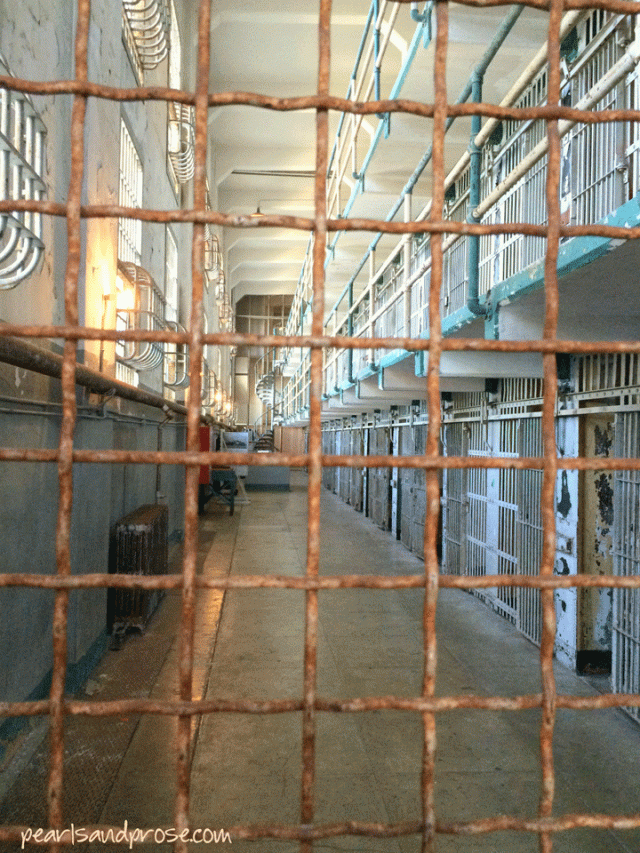Alcatraz Island is only 1.25 miles (2.01 km) off the coast, so it was a short ferry ride from San Francisco. I missed seeing it in years past because I didn’t know you had to reserve waaaay in advance. It’s a bit easier in the winter when there aren’t so many tourists.

Here’s our ride. We had perfect weather, so I was able to stay outside for photos.
The views from the ferry weren’t too shabby at all:

San Francisco skyline

Bay Bridge

Golden Gate Bridge
And then, our first sighting of Alcatraz.

In 1846, John C. Fremont, Military Governor of California, bought the island for $5,000.
Then in 1850, President Fillmore ordered that Alcatraz Island be set aside as a U.S. military reservation following the acquisition of California from Mexico after the Mexican-American War.
A little closer.

At first I thought the tall structure was a guard tower. It’s actually the oldest operating lighthouse on the West Coast of the U.S., completed in 1854.

We came in from the north. This is Building 64, which houses a very nice bookstore on the first level. Not sure what they use the rest of the building for now, but it used to be apartments for employees. That’s the main prison on top of the hill.

Thought you might want to read the “welcome sign.” More about the Native Americans later.
On our way up to the prison, we took in the beautiful views and other buildings. The contrast between the penitentiary and the surroundings was pretty stark.



San Francisco Bay is just so beautiful.

Electrical repair shop.

Another view.

Looks like something from Al Capone’s time, doesn’t it?

This little prisoner was especially poignant. Juan Manuel de Ayala, a Spaniard, named the island “La Isla de los Alcatraces,” or “The Island of the Pelicans.” The name was later shortened to Alcatraz. I really hope someone freed this pelican.
Random fact: The “Birdman of Alcatraz” movie wasn’t quite accurate. Robert Stroud, the Birdman, was jailed with his birds at Leavenworth Prison. When moved to Alcatraz, he wasn’t allowed to keep any pets. Stroud spent 42 years in solitary confinement!

The remains of the Officers Club.
From November 20, 1969, to June 11, 1971, eighty-nine American Indians occupied the island under the Treaty of Fort Laramie. During the occupation, this building, the recreation hall, the Coast Guard quarters and the warden’s home were destroyed by fire.

The main prison block looming above. Construction began in 1909, but before that, in 1867, a brick jailhouse was built and in 1868, Alcatraz was designated a long-term detention facility for military prisoners.
We then entered the prison and basically took the same path as incoming prisoners.
First stop, showers:

When we walked through this area I was busy taking it in and shooting photos. Looking at it now, I’m kind of creeped out.

B Block. Alcatraz was a federal prison from 1933 until 1963 when Attorney General Robert F. Kennedy ordered the penitentiary closed on March 21.

Some of the more famous prisoners besides the Birdman of Alcatraz were Al Capone and George “Machine Gun” Kelly.
We saw all kinds of cells:

Most of the prison cells measure 9 feet (2.7 m) by 5 feet (1.5 m) and 7 feet (2.1 m) high.

Corridors of the prison were named after major American streets such as Broadway and Michigan Avenue.

The cells were stacked three high. I think they look like rat cages here.

One of the “nicer” cells.
More next week.
Hope your week’s going well so far.
{carole}


Loved the skyline pictures. Gorgeous ones. 🙂
Thanks so much!
Fantastic! I really enjoyed this. I have been a fan of American gangster films since I was a kid in the ’50’s so just to see the place in your superb photos was a treat.
Thanks for the visit and kind comment! I’ll have more next week.
A very big contrast between nature outside and the life inside! Yeah, creepy! But it’s interesting, Carole!
Glad to hear it’s interesting! I try to edit down the facts so as to not put people to sleep. 🙂
No, it’s impossible, your post is very intriguing!
You are so kind.
What history – and you’re correct – those cell blocks look like rat cages in an eerie lab somewhere. Yikes – 9 x 5 x 7 is AWFULLY small !
I know people were a lot smaller then, but still!
Reblogged this on authorgwendolyncurrandotcom.
Thank you for the re-blog. 🙂
Melancholy is the right word to describe this place, Carole.
I just read a review of a novel, The Edge of Lost, which takes place partly in Alcatraz in 1937. Now that I see your photos, I am definitely picking up this book. http://www.shereads.org/the-books-of-winter/
I’ve been thinking of watching Escape From Alcatraz with Clint Eastwood too, Jackie. Not sure I could read a more realistic book, though. The descriptions of solitary confinement are truly terrible. Had no idea Alcatraz was considered one of the toughest prisons in its day.
It’s so strange that we don’t use this gorgeous spot of real estate for anything else.
I thought that more than once while touring the place. Evidently the salt air is murder on the buildings and equipment. (No pun intended.)
But it seems like it could be returned to a natural state and could become an interesting tourist spot as a bird reserve or a spot for the seals in the bay.
I agree. Ironically, it’s the National Park Service that runs the place now. I imagine historians would be very upset if the prison were razed.
you have covered it nicely 🙂
Thanks so much! I took a lot of photos. 🙂
Great shots. I wish I had visited Alcatraz when I was in San Fracisco but I ran out of time.
It took me many years to get there, Caroline. There’s so much to see in the city, it’s hard to do everything.